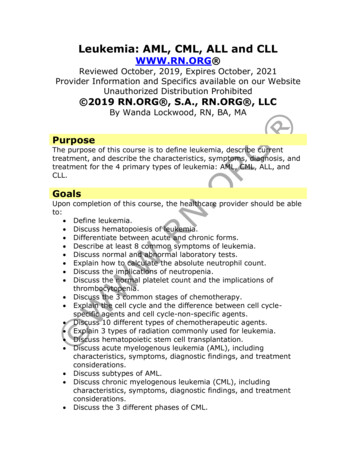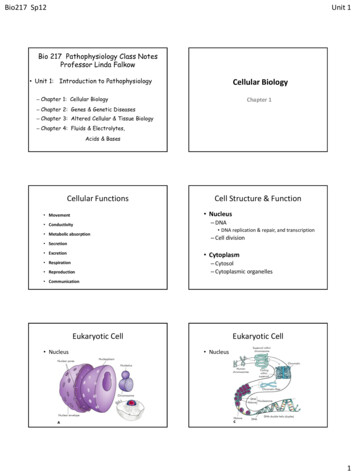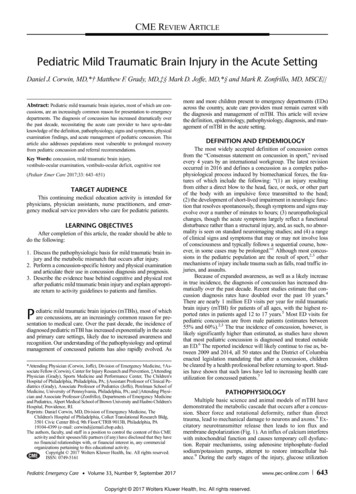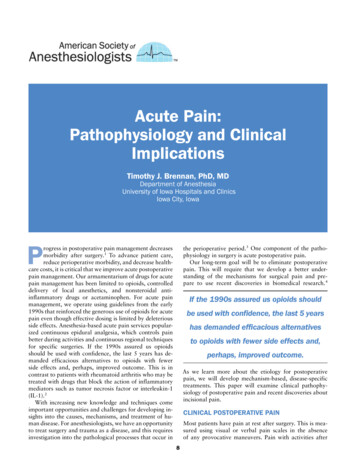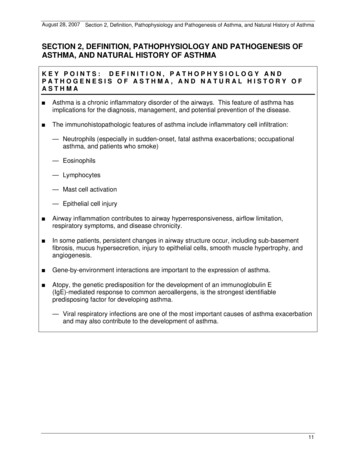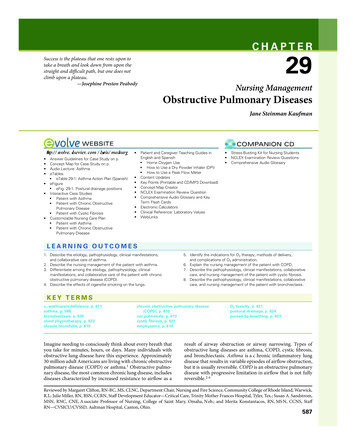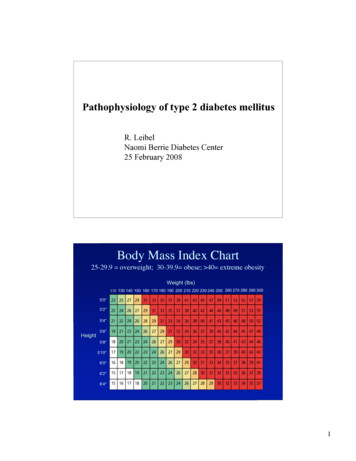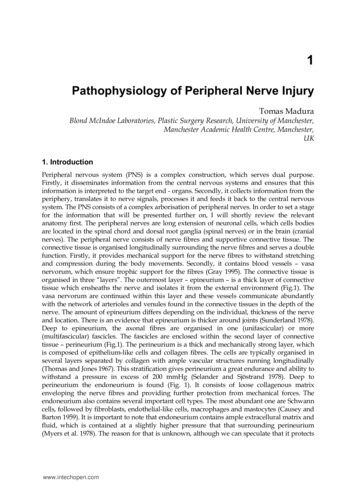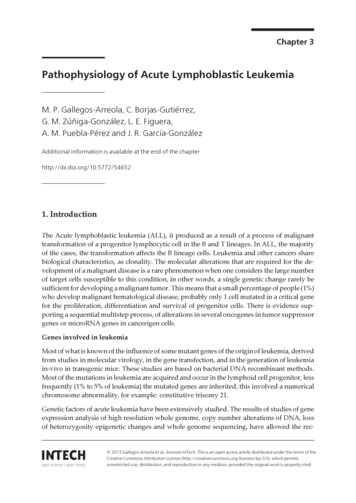
Transcription
Chapter 3Pathophysiology of Acute Lymphoblastic LeukemiaM. P. Gallegos-Arreola, C. Borjas-Gutiérrez,G. M. Zúñiga-González, L. E. Figuera,A. M. Puebla-Pérez and J. R. García-GonzálezAdditional information is available at the end of the chapterhttp://dx.doi.org/10.5772/546521. IntroductionThe Acute lymphoblastic leukemia (ALL), it produced as a result of a process of malignanttransformation of a progenitor lymphocytic cell in the B and T lineages. In ALL, the majorityof the cases, the transformation affects the B lineage cells. Leukemia and other cancers sharebiological characteristics, as clonality. The molecular alterations that are required for the de‐velopment of a malignant disease is a rare phenomenon when one considers the large numberof target cells susceptible to this condition, in other words, a single genetic change rarely besufficient for developing a malignant tumor. This means that a small percentage of people (1%)who develop malignant hematological disease, probably only 1 cell mutated in a critical genefor the proliferation, differentiation and survival of progenitor cells. There is evidence sup‐porting a sequential multistep process, of alterations in several oncogenes in tumor suppressorgenes or microRNA genes in cancerigen cells.Genes involved in leukemiaMost of what is known of the influence of some mutant genes of the origin of leukemia, derivedfrom studies in molecular virology, in the gene transfection, and in the generation of leukemiain-vivo in transgenic mice. These studies are based on bacterial DNA recombinant methods.Most of the mutations in leukemia are acquired and occur in the lymphoid cell progenitor, lessfrequently (1% to 5% of leukemia) the mutated genes are inherited, this involved a numericalchromosome abnormality, for example: constitutive trisomy 21.Genetic factors of acute leukemia have been extensively studied. The results of studies of geneexpression analysis of high resolution whole genome, copy number alterations of DNA, lossof heterozygosity epigenetic changes and whole genome sequencing, have allowed the rec‐ 2013 Gallegos-Arreola et al.; licensee InTech. This is an open access article distributed under the terms of theCreative Commons Attribution License (http://creativecommons.org/licenses/by/3.0), which permitsunrestricted use, distribution, and reproduction in any medium, provided the original work is properly cited.
44Clinical Epidemiology of Acute Lymphoblastic Leukemia - From the Molecules to the Clinicognition of new genetic alterations, so that virtually all patients with ALL can be classifiedaccording to the specific genetic abnormality. This information has increased our knowledgeof leukemogenesis, the prognosis and has served as the basis for the development of the targettherapy. However, the understanding of how genetic alterations collaborate to induce leuke‐mic transformation remains unclear.The altered genes in the leukemia can be result in loss or gain of the function through severalmechanisms, for example: abnormal recombination (chromosomal, translocation, inversion,insertion) loss of genetic material (deletion) gain of genetic material (duplication) point mu‐tation and the presence additional copies of certain chromosomes as in the case of hyperdi‐ploidy; previous alterations favoring the activation of oncogenes, this encode proteins thatcontrol cells proliferation, apoptosis or both.The advances in the conventional cytogenetic techniques, as the fluorescence in situ hybridi‐zation, have shown the chromosomal rearrangements. In this sense, recently has been reportedthat the incidence of chromosomal change is related with the age, so the translocation t(9;22)(q34;q11) increases in each successive decade, up to 24% between the 40-to 49 years old, thet(4;11) (q21;q23) and t(1;19) (q23;q13) are rare in patients older than 60 years old, but t (8;14)(q24;q32) and t(14;18)(q32;q21) increased with age. The hiperdipoidia occurs in 13% of patientsunder 20 years old and only 5% of elderly patients. The hypodiploidy and complex karyotype(presence of more than 2 chromosomal abnormalities) also increase with age of 4% in the rangeof 15 to 19 years old to 16% older than 60 years old.When an oncogen is activated by mutation, encoded protein is structurally modified so thatenhances its transforming activity, thus remains on active status, continuously transmittingsignals through the binding of tyrosine and treonina cinasa. These signals induce cell growthcontinued incessant. This mechanism of activation of ocogenes is more evident in others formsof leukemia, for example: severe myeloblastic leukemia and other myelodysplastic syndromeswhere the genes NRAS are mutated. There are mutations that suppress the function and areobserve in tumor suppressor genes such as TP53, however, less than 3% of patients with ALLare TP53 mutations, although all cells have a resistance abnormal apoptosis induced by lackof significant proportion of p53, which is explained in large part by epigenetic medications.By other hand, some authors have found alterations in the number of copies (ANCs) to 50recurrent regions in ALL, some are really small and they have less than 1 Mb, however occurin genes encoding regulatory proteins of normal lymphoid development in 40% of cases ofALL progenitors B. The target most common are lymphoid transcription factor PAX5 that havedeletions or amplifications until 30% of cases with ALL-B, also found in genes ANCs of tran‐scription factor IKZF1 the IKZF3, EBF1, LEF1 and TCF3, RAG1 and RAG2.Another important point, is the dihydrofolate reductase (DHFR) gene amplification has beenconsidered as the most relevant in the ALL, this amplification produce cytogenetic abnormal‐ities evident as the amplified of high DNA segment that included some hundreds of kilobases.The ALL of T-cell type represents about 10% to 15% of the ALL in adults and the 25% in childrenand their clinical behavior is the most aggressive, the patients have a higher percentage offailure of remission induction, relapse rate is also higher, and had infiltration at central nervous
Pathophysiology of Acute Lymphoblastic Leukemiahttp://dx.doi.org/10.5772/54652system compared with B-cell ALL. In this sense, is known that the oncogenes and tumor sup‐pressor genes are implicated in ALL-T are: c-MYC, NOTCH, LMO1 / 2, LYL1, TAL1 / 2, Hox11and HOX11L2. It is clear that NOTCH activated is able to induce leukemogenesis of T cell andthis is critical for the progression to ALL-T. Family members of NOTCH are transmembranereceptors that are involved in controlling the differentiation, proliferation and apoptosis inseveral cell types including T cells. The binding of its ligand to the extracellular domain, re‐sulting in cleavage of the intracellular domain of NOTCH, this reaction is catalyzed by γsecretase complex, and the intracellular domain free of translocase to the nucleus, thatregulates transcription of genes regulated by NOTCH.The NOTCH target genes are mainly cyclina D1 and c-Myc. Both NOTCH as c-MYC regulatecell cycle progression by inducing expression of cyclins and reduced expression of p27. Animportant aspect is that NOTCH is able to inhibit apoptosis induced by p53 allowing the tumorregression. In the development of ALL-T there is strong evidence of pro-oncogenic functionof signals transduced by NOTCH, and that modulates the activity of downstream signalingpathways, through transcriptional regulation of their target genes. Is possible regulators ofsignaling downstream of NOTCH especially in murine models are some intermediate signal‐ing routes as: phosphatidylinositol 3-kinase (PI3K), Akt / protein kinase B, extracellular signalregulated kinase-1/2, and nuclear factor kB. In general, the products of oncogenes can beclassified into six categories: transcription factors, chromatin remodeling, growth factors,growth factor receptors, signal transducers, and finally regulators of apoptosis. Transcriptionfactors generally require interacting with other proteins to act, for example: Fos transcriptionprotein dimerizes with the transcription factor Jun to form the AP1 transcription factor is reallya complex, and this increases the expression of several genes control cell division, all they havebeen involved in the development of leukemia.Aberrant methylation of CpG sites in promoter regions of genes has been identified in ALLcell lines, to respect it is important to note that methylation of CpG dinucleotides in positionnear the site of transcription initiation can silence gene expression, hypermethylation of tumorsuppressor genes and hypomethylation of oncogenes can lead to various forms of cancer.Other mechanism important in the development of the ALL is the angiogenesis and signaltransducers on the binding of tyrosine kinase receptors, finally the molecules regulators of theapoptosis, where the BCL2 gene encodes for a cytoplasmic protein that is localized in themitochondria and increases the survival of the cell by inhibiting apoptosis.Secondary leukemiasSecondary hematological malignancies are a serious complication of cancer treatment. Theyusually manifest as acute leukemias and myelodysplastic syndromes. This also touch the itemon secondary leukemias and its frequency is high and has increased possibly due to increas‐ingly frequent use of genotoxic agents and by increased survival to other types of cancer. So,learn more about these could eventually help reduce its appearance. It is known that this typeof leukemia may arise as a result to exposure to cytotoxic treatments (side effects of genotox‐icity) and / or radiation therapy and as a result of other blood disorders; probably as a result45
46Clinical Epidemiology of Acute Lymphoblastic Leukemia - From the Molecules to the Clinicof environmental or genetic causes. In particular in this we will focus more on the former. Inmost cases it is suggested that the mechanism of leukemogenesis is associated with DNAdamage of hematopoietic cells from bone marrow by agents such as those used in chemother‐apy. Although the majority of secondary leukemias are acute myeloid leukemia (AML) hasbeen reported cases of lymphoid leukemia and chronic myeloid leukemia (CML) associatedwith chemotherapy treatments. Finally, we intend to touch points as the classification of sec‐ondary leukemias, its relationship to chemotherapeutic agents and ionizing radiation, etiolo‐gy, individual susceptibility, pathogenesis, and treatment as well as their behavior in infantsand adults.In this way one can conclude that the pathophysiology of ALL involved mechanisms geneticand environmental complex at different levels, and also have a close and complex relationship.The key features in the pathophysiology of the ALL is its monoclonal origin, uncontrolled cellproliferation by sustained self-stimulation of their receptors for growth, no response to inhib‐itory signals, and cellular longevity conditioned by decreased apoptosis.Acute lymphoblastic leukemia (ALL) is the result of a process of malignant transformation ofprogenitor cell lineage of the B and T lymphocytes. (Pui et al, 2011) In most cases of ALL, thistransformation affects B lineage cells. (Heltemes et al, 2011)In the last 3 decades, there has been a significantly improvement in treatment outcome of ALLin children, 70% to 80% of children can get cured of their disease, a situation that is differentin adults with ALL, since only 30% -35% of them may heal. (Sotk et al, 2000; Mullighan andDowning, 2009)The required molecular alterations, for the development of malignant disease, are a rare phe‐nomenon, when it is considered the large number of target susceptible cells to such alteration(Greaves, 2002) ie, a single genetic change is unlikely to be sufficient for the development of amalignant tumor (Croce, 2008), this means that in a very low percentage of people (1%) isdeveloped a hematologic malignancy, only 1 cell will likely experience a mutation in a criticalgene for proliferation, differentiation and survival of progenitor cells (Greaves, 2002), that swhat we mean when we mention the monoclonal origin of cancer.It is important to mention that when we refer to the origin of cancer, in this cases ALL, ref‐erence is made to the terms: Cell Origin and Stem Cell Cancer. Actually, the concept im‐plies that normal cells of distinct origin acquire the first mutation(s) to promote cancer, ie,that is the cell that will initiate the cancer, while the cancer stem cell will disseminate it(figure 1). (Visvader, 2011)Malignant diseases, including acute leukemias, show a marked heterogeneity in cellular mor‐phology, rate of proliferation, genetic lesions and, as a result, the response to treatment. Themolecular mechanisms, underlying the heterogeneity of malignant neoplasia, are importantpoints in the study of the cancer’s biology. (Visvader, 2011) Above mentioned alterations maybe due to somatic mutations, although alterations in the germline may predispose to familial(or hereditary) cancers. (Croce, 2008)
5Pathophysiology of Acute Lymphoblastic Leukemiahttp://dx.doi.org/10.5772/54652Stem CellCommon progenitorCommitted progenitorMatured cellsFigure 1. Cell origin and evolution of a cancer stem cell (modified of Visvader, 2011)There is growing evidence that supports a multi-step process in leukemogenesis, ie, sequentialsteps and serial number of alterations in oncogenes, tumor suppressor genes, or microRNA genesin cancer cells. (Greaves, 2002; Croce, 2008) Oncogenes are dominant genes that once mutated,from a normal cellular gene (proto), encode abnormal proteins that cannot control cell prolifera‐tion, apoptosis, or both, thereby contributing to cancer development. (Pierce, 2009)A suppressor gene normally inhibits cell division, and favors the growth of cancer when bothalleles are mutated, i.e., they are recessive mutations, where the lack of function of both allelesis promoting the development of malignancy. (Pierce, 2009)Unlike the genes involved in cancer development, microRNA genes do not encode proteins,their products are small RNA molecules (single strands of 21 to 23 nucleotides) that recognizeand bind a nucleotide sequence of messenger RNA (mRNA), to the complementary microRNAsequence, and thus blocking the translation of protein from mRNA; then, their function is toregulate gene expression. (Calin et al., 2002; Croce, 2008)2. Genes involved in the leukemiasMuch of what we know about the great influence of certain mutant genes, in the origin ofleukemia, is derived from mouse transgenesis studies in molecular virology, with gene trans‐fection and the generation of leukemia in vivo. These studies are based on bacterial recombinantDNA methods. (Pui et al, 2011)This knowledge has increased our understanding of leukemogenesis and prognosis, and ad‐ditionally has served as foundation for the development of targeted therapy. However, thecomprehension of how genetic alterations that collaborate to induce leukemic transformationis not clear yet.(Pui et al, 2011)47
48Clinical Epidemiology of Acute Lymphoblastic Leukemia - From the Molecules to the ClinicMost mutations in leukemia are acquired, and occur de novo in the lymphoid progenitor cells,less frequently (1% to 5% of leukemias) the mutated genes are inherited (vgr, p53, DNA ligase),or a numeric chromosomal abnormality is involved, for example constitutive trisomy 21.(Greaves, 2002)Acute leukemias are the most studied malignant disorders from a genetic standpoint, the re‐sults of whole-genome studies, e.g.: gene expression analysis of high-resolution, genome-widealterations in DNA copy number variation (CNA), loss of heterozygosity, epigenetic changes,and complete genome sequencing have favored the recognition of new genetic alterations,then virtually all patients with LLA can be classified according to the specific genetic abnor‐mality, as shown in Figure 2, which is evident in children with ALL the high frequency ofgenetic abnormalities. (Mullighan et al, 2007; Pui et al, 2011)Figure 2. Frequency of genetic abnormalities in childrenwith ALL. (modified of Puiet al, 2011.)As discussed previously, the altered genes in leukemia can result in loss or gain of function,and this is achieved through various mechanisms, for example, abnormal recombination(chromosomal translocation, inversion, or insertion), loss of genetic material (deletion), gainof genetic material (duplication), or mutation. Also can be present additional copies of certainchromosomes, as in the case of hyperdiploidy. With these chromosomal alterations, the acti‐vation of oncogenes is favored. Oncogenes can be activated by: chromosomal rearrangements,gene mutation and gene amplification. (Croce, 2008)i.The demonstration of chromosomal rearrangements have been evidenced by im‐proved conventional of cytogenetic study. The standard analysis can detect primarychromosomal abnormalities in more than 75% of all cases. (Liang et al, 2010)Recently, it was reported that the incidence of chromosomal alterations is associated with age.(Moorman et al, 2010) In fact, age is a determining factor in the prognosis and treatment out‐come for patients with ALL. In long term survival, the rates are close to 80% in children under5 years of age, but will decrease to 50% or 60% in adolescents and young adults, and approx‐imately 30% in adults of 45 to 54 years, but rarely exceed 15% in older adults. The Philadelphiachromosome (Ph) is the most common cytogenetic abnormality associated with ALL in adults.(Zuo et al, 2010; Lee et al, 2011)
Pathophysiology of Acute Lymphoblastic Leukemiahttp://dx.doi.org/10.5772/54652The Philadelphia chromosome positive (Ph ) ALL is a product of reciprocal translocation be‐tween the long arm of chromosome 9(q34), where the oncogene ABL1 is located, and the longarm of chromosome 22(q11), where the BCR gene lies, leading to the formation of the BCRABL1 chimeric protein (Figure 3), and as a result of this fusion the Bcr-Abl tyrosine kinase,constitutively active, is produced, which is responsible for the acute and chronic leukemiaforms. (Martinelli et al, 2009)Figure 3. Philadelphia chromosome translocation (translocation between 9 and 22 chromosomes). (modified of Satter‐and James, 2003)This alteration is relatively rare (approximately 5%) in infants with ALL, but not in adultswhere its frequency range between 20% and 30%, it was the first known cytogenetic abnor‐mality associated with chronic myeloid leukemia (CML) and Ph ALL.Despite the Ph ALL occurs in only about 5% of patients under 20 years of age, the incidenceincreases to 33% in patients over 40 years and it reaches 49% in patients over 40 years, todecrease the incidence to 35% in patients over 60 years. (Lee et al, 2011)A significant proportion of patients with ALL Ph (approximately 85%), and high-risk ALLwithout BCR-ABL1 fusion ( 28%), have IKZF1 gene deletion, and both situations are associatedwith adverse prognosis. (Martinelli et al, 2009; Cazzaniga et al, 2011)The gene IKZF1 is located on 7p12, and encodes the transcription factor Ikaros, which is amember of the family of transcription factors containing zinc fingers (Martinelli et al, 2009).Deletion of IKZF1 is not observed in the chronic phase of CML, but is detected in two out ofthree samples analyzed during the lymphoid blast crisis. (Mullighan et al, 2009) IKZF1 genomicalterations, causing loss expression or expression of dominant negative isoforms, are criticalin the pathogenesis of BCR-ABL1 ALL Ph . (Mullighan et al, 2009)Almost half of patients with BCR-ABL1 ALL and lymphoid blast crisis CML also harbor de‐letion of CDKN2A/B and PAX5 genes; approximately 20% of these cases have deletion of the49
50Clinical Epidemiology of Acute Lymphoblastic Leukemia - From the Molecules to the Clinicthree genes. These data support the concept that it is required the alteration of several cellularpathways to induce the development of ALL. It has been correlated the ALL IKZF1 focal de‐letion with clinical response to treatment, overall response rate of relapse and disease-freesurvival; and it has also been shown that deletion of Ikaros gene represents the most importantprognostic factor so far described, in ALL Ph .(Mullighanh et al, 2009; Martinelli et al, 2009)Other chromosomal abnormalities associated with age are the t(4;11)(q21;q23) and t(1;19)(q23;p13), that are rare in patients older than 60 years of age, but on the other way t(8;14)(q24;q32) and t(14;18)(q32;q21) increases with age. (Moorman et al, 2010)The translocation t(4;11)(q21;q23) leads to the formation of the MLL-AF4 fusion gene, and isresponsible for more than 50% of ALL cases in children younger than 6 months in 10-20% ofolder infants, in approximately 2% of children and only 10% of adults with de novo ALL. Chro‐mosomal abnormality in adults with ALL is considered to be of high risk. (Marchesi et al, 2011)The gene Mixed Lineage Leukemia (MLL) is frequently involved in hematological malignan‐cies, particularly acute leukemia, both lymphoblastic and myeloblastic, it is located at 11q23,and plays an important role in the positive regulation of gene expression during early embry‐onic development (ie it is a HOX gene) and also in hematopoiesis. (Marchesi et al, 2011)MLL gene encodes a 500 kD protein containing several conserved functional domains, a targetof proteolytic activity of Caspasa 1, a cleaving protein specialized in N-terminal fragments of320 kD and C-terminal of 180 kD. This latter is responsible for methyltransferase activity inlysine 4 of histone H3 (H3K4), which mediates changes in chromatin associated with epigenetictranscriptional activation. (Milne et al, 2002; Hsieh et al, 2003)The main chromosomal alterations that may occur with the MLL gene are mainly reciprocaltranslocations, causing fusion with other different genes, and partial tandem duplication ofgenes. (Schnittger et al, 2000)Translocations in which MLL gene is involved can result in a chimeric protein, that fuses theMLL N-terminal with the C-terminal portion of the associated genes; the methyltransferasedomain (SET domain) is invariably lost in the MLL fusion protein. This fusion of genes canalter normal cellular proliferation and differentiation processes, which favors leukemogenesis.(Ayton et al, 2001)MLL gene is a target of about 104 different rearrangements, of which 64 are translocations withother genes. The proteic products of the fusions are nuclear localization signals, and play animportant function as potent transcription factors. (Meyer et al, 2009)Genes that most commonly fuses with MLL gene are, in order of frequency: AF4, AF9, ENL,AF10, AF6, ELL, and AF1P. The leukemias that express the fusion gene MLL-AF4 are diagnosedprimarily as pro-B, in pediatric and adult patients, while the fusion with genes AF9, AF6, orAF10 are common in AML subtypes myelomonocytic or monoblastic variety. (Kohlmann etal, 2005; Moriya et al, 2012)The t(1;19)(q23;p13) is recurrent in children and adults, and results from the fusion of geneTCF3 transcription factor 3 (E2A immunoglobulin enhancer binding factors E12/E47) locat‐
Pathophysiology of Acute Lymphoblastic Leukemiahttp://dx.doi.org/10.5772/54652ed at 19p13.3, with gene pre-B-cell leukemia homeobox 1 (PBX1), located at 1q23.3, the fu‐sion gene TCF3 (E2A)-PBX1 encodes a chimeric protein with transforming properties. (Garget al, 2009)The gene encoding E2A transcription factors E12 and E47 binds enhancer elements of thegene of κ light chains of immunoglobulins, as well as some other gene regulatory ele‐ments. (Garg et al, 2009)The transcriptional activator domain of the chimeric protein encoded by the fusion gene E2APBX1 is provided by E12/E47, and the DNA binding domain is provided by the (HOX) Home‐box PBX1, this protein promotes leukemogenesis by activation of several genes that are notnormally expressed in lymphoid tissues. (Garg et al, 2009)The t(12; 21)(p13, q22) is a consequence of gene fusion ETV6/RUNX1 (also known as TEL/AML1) and is the hallmark of one of the most common genetic subtypes of ALL of precursorof B cells in children, in whom is the most common molecular genetic alteration occurring in20% to 25% of pediatric cases; while in adults this translocation is rare. (Pui et al, 2011)The current model involves several steps, the fusion of these genes can occur already duringfetal development and is the initial event, but is not sufficient for the neoplastic transformation(Fuka et al, 2011). Indeed, the development of ALL of infancy B cell lineage involves (at least)2 genetic events (hits), the first of which often arises in prenatal stage. (Thomsen et al, 2011)The fusion gene that encodes a chimeric transcription factor, involves the N-terminus of theprotein ETV6 and the most of the RUNX1 protein, it is believed that normally RUNX1 acts asa modulator of transcription; transcriptional repressor becomes the target genes RUNX1. (Fukaet al, 2011)Hyperdiploidy is detected in approximately 25-30% of children with ALL precursor B cells. Inthese patients the clinical phenotype is usually associated with low risk and good prognosis.(Grumayer et al, 2002; Pui et al, 2011) It is interesting to mention that a hyperdiploid karyotyperefers to a higher number of chromosomes than the normal diploid number (e.i., greater than46 chromosomes), but having a chromosome number that is not a multiple of the haploid number(23 chromosomes), the modal number can be located between 47-57 chromosomes (Shaffer etal, 2009). This karyotype arises through a simultaneous gain of multiple chromosomes, froma diploid karyotype, during a single abnormal cell division. (Grumayer et al, 2002)The hyperdiploidy occurs in 13% of young adults, and only 5% of elderly patients. The hypo‐diploidy and complex karyotype (presence of more than 2 chromosomal abnormalities) alsoincrease with age, from 4% in the range of 15 to 29 years of age and 16% older than 60 years.(Moorman et al, 2010)ii.When an oncogene is activated by mutation, the encoded protein is structurallymodified in such a way that increases their transforming activity, ie, remains in theactive state, continuously transmitting signals by binding of tyrosine and threoninekinase. These signals induce cell growth continued incessant. This mechanism of ac‐tivation of oncogenes is more evident in other forms of leukemia, for example, AMLand myelodysplastic syndromes (MDS) where the NRAS gene is mutated. There are51
52Clinical Epidemiology of Acute Lymphoblastic Leukemia - From the Molecules to the Clinicmutations that suppress the function, and it is observed in tumor suppressor genessuch as TP53, however, less than 3% of patients with ALL have TP53 mutations, al‐though all the cells have abnormal resistance to apoptosis induced by lack of a sig‐nificant proportion of p53, which is explained in large part by epigenetic. (Zornozaet al, 2011)On the other hand, some authors have found change in the number of copies (CNVs) to 50regions in ALL recurring, some are very small and have less than 1 Mb, however, occur ingenes encoding regulatory proteins of normal lymphoid development up to 40% of cases ofALL stem B. The most common targets are lymphoid transcription factor PAX5, that can holddeletions or amplifications in up to 30% of cases of ALL-B, also found CNVs in transcriptionfactor genes IKZF1, the IKZF3, EBF1 (factor Cell B early), LEF1 and TCF3, and RAG1 and RAG2genes. (Mullighan et al, 2009)iii.The most relevant gene amplification in LLA is the dihydrofolatereductase (DHFR).The amplification of this gene causes evident cytogenetic alterations because the am‐plified DNA segment may involve several hundred kilobases. (Croce, 2008)A variety of acute leukemia to consider is the T-cell ALL (ALL-T), it represents about 10% to15% of ALL in adults and 25% of children. The clinical behavior is more aggressive, patientshave a higher percentage of failure of remission, relapse rate is also higher as well, and thecentral nervous system infiltration compared with B-cell ALL type. (Demarest et al, 2011)Oncogenes and tumor suppressor genes that have been implicated in T-ALL are: c-MYC,NOTCH, LMO1 / 2, LYL1, TAL1 / 2, Hox11 and HOX11L2. It is clear that activated Notch is ableto induce T cell leukemogenesis and is critical for the progression to T-ALL. (Demarest et al,2008)Members of the NOTCH family are transmembrane receptors that are critically involved incontrolling the differentiation, proliferation and apoptosis in several cell types including Tcells. The Notch receptor binding to its ligand exhibits a cleavage site for extracellular ADAMmetalloproteinase, and a cleavage site in the transmembrane region for the γ-secretase, thusreleasing the intracellular domain of Notch, which transmits this signaling to the cell nucleus,where it is associated with a DNA-binding complex. (Palomero et al, 2006; Chan et al, 2007;Sanda et al, 2010; Gomez et al, 2012)Notch signaling cooperates with the signaling of T cell receptors (TCR) to expand the numberof thymocytes undergoing β-selection. Over 50% of T-cell ALL have activating mutations inNotch1. (Gomez et al, 2012)NOTCH target genes are mainly cyclin D1 and c-Myc. Both Notch and c-Myc regulates cellcycle progression by inducing expression of cyclins and reduced expression of p27. An im‐portant aspect to point out is that Notch is able to inhibit apoptosis induced by p53. WhenNotch expression is suppressed, the p53 pathway is activated and leads to tumor regression.(Demarest et al, 2008; Sanda et al, 2010)An important aspect of Notch, is that depending on the type of cells, the extracellular en‐vironment, and the intensity of the signal, Notch can transmit signals as pro-oncogenic or
Pathophysiology of Acute Lymphoblastic Leukemiahttp://dx.doi.org/10.5772/54652tumor suppressor (Leong and Karsan, 2006). In the development of T-ALL there is strongevidence of pro-oncogenic function of signals transduced by Notch, and that modulates theactivity of downstream s
The key features in the pathophysiology of the ALL is its monoclonal origin, uncontrolled cell proliferation by sustained self-stimulation of their receptors for growth, no response to inhib‐ itory signals, and cellular longevity conditioned by decreased apoptosis.
